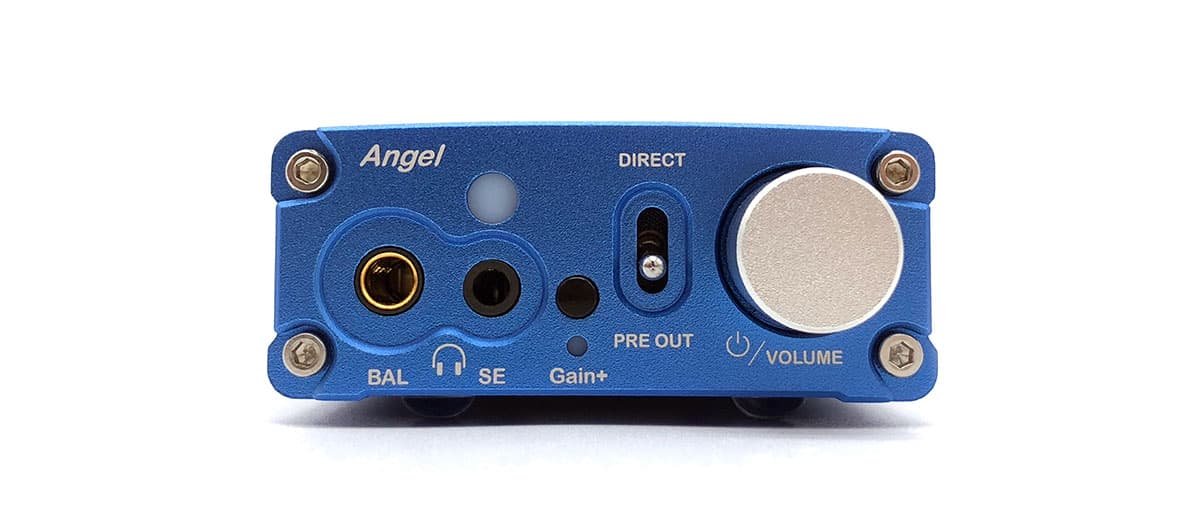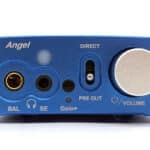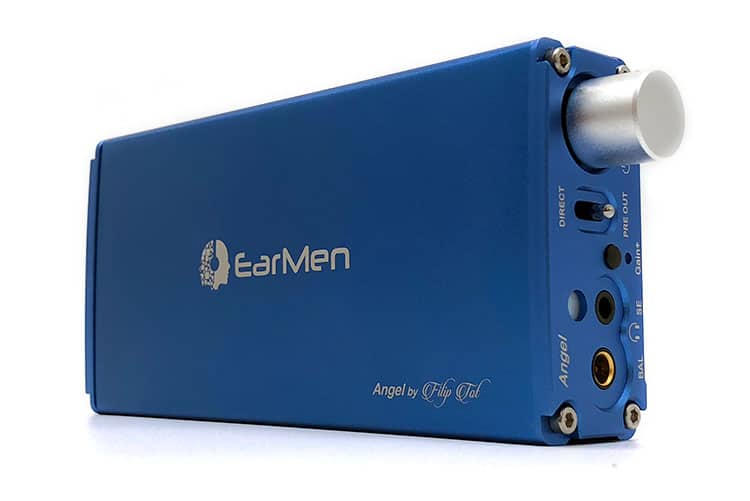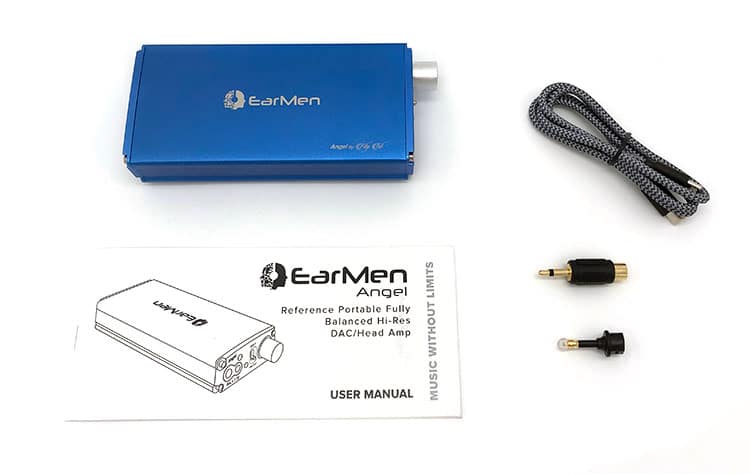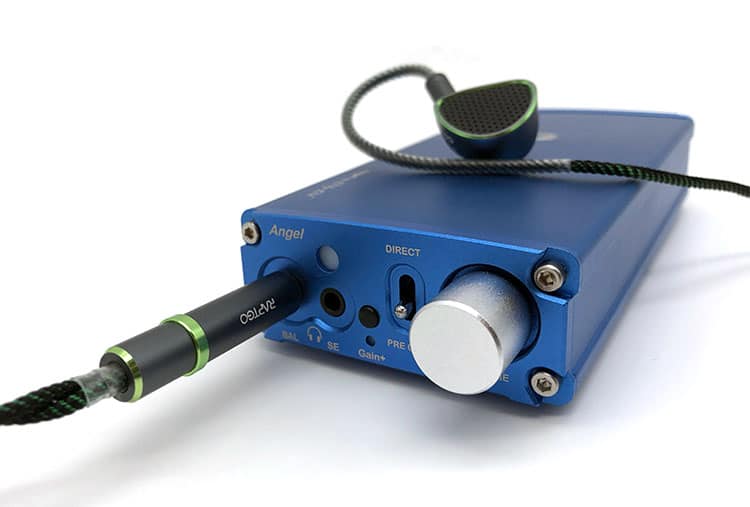Today, we review the EarMen Angel which is a new portable balanced headphone amplifier with an integrated MQA-capable ES9038Q2M DAC. It is priced at $799.
Disclaimer: This is a sample sent to us in exchange for our honest opinion. Headfonics is an independent website with no affiliate links or status. We thank EarMen for their support.
To learn more about EarMen products previously featured on Headfonics you can click here.
Note, this article follows our latest scoring guidelines which you can read up on here.
EarMen recently beefed up their repertoire with the announcement of the Angel, CH-Amp, and Staccato. And we’re beginning with their $799 portable DAC/Amp today to see if it is up to par.
Enchantingly named ‘Angel’, it shares the winged naming element with the more portable segment of EarMen’s lineup. But if we are to look closely at their other DAC/Amp called the TR-Amp, the similarity here in features is more prominent.
Looking around the market, what’s interesting is the limited number of options competing against the Angel that’s priced in the same category. This places an attractive challenge for EarMen to compete against the likes of CEntrance and Chord Electronics.
Tech Highlights
The DAC chip EarMen decided to use for the Angel is the ES9038Q2M, a balanced capable converter from ESS designed for portable devices.
It may not be groundbreaking since this chip has been widely used in the industry for quite some time now but it is the same one installed in the Tradutto so it might prove its worth.
With the latest XMOS USB receiver inside, the Angel will be able to cover most modern media at up to 32bit/768kHz PCM, native DSD512, and even MQA.
The fully balanced circuitry of the Angel boasts a 120dB dynamic range with a keen focus on keeping the signal intact. There is also a linear power supply hiding inside of the Angel getting a good handle in keeping noise low.
What is providing power to the Angel when on the go are two 3000mAh lithium polymer batteries. With a charge time of 3 hours and a separate port for charging, there is no excuse for the Angel to be out of energy when you need it.
Design
Seeing the TR-Amp, which is another portable DAC/Amp from EarMen, I couldn’t help but see the similarities between the two. The easiest way to describe the Angel to those who have owned or seen the TR-Amp is to elongate its chassis and move some bits and pieces around to make the device fit today’s standards.
Doing away with the 6.35mm and RCA sockets of the TR-Amp, the Angel is making use of a more compact set of 3.5mm and 4.4mm jacks to highlight the amplifier’s balanced design.
The Angel also moved the preamp switch to the front and grew in features adding a new Gain+ button and the ability to interface through a S/PDIF connection.
Four visible screws are holding the three-piece assembly of the Angel together. It is one of the more prominent features used by EarMen to add a layer of depth to the otherwise simple case of the device.
The Angel is a solid device to carry around. Not just with build and weight, where the 340g chassis won’t disappoint in offering a premium impression, but in ergonomics as well.
Even though the metal finish is quite smooth, the Angel won’t be awkward to hold on to from its softly curved top and sunken sides.
One final thing worth noting is the volume wheel since there might be a difference in what end users will get. Their official website shows EarMen is marketing the Angel with a black analog volume indicator, but the review unit we have here has a silver digital controller.
I/O
Looking very sleek, the Angel keeps a tidy profile thanks to its flush-mounted sockets. EarMen carefully considered a nice assortment of capable ports in both the front and rear sections of the unit without sacrificing usability.
To start with the short but sweet list of inputs, the Angel will accept data from any digital downstream source using its USB-C and S/PDIF inputs. And seeing that the S/PDIF hardware on the Angel will neither accept a traditional coaxial nor TOSLINK cable, EarMen decided to include adaptors for each.
A separate USB-C is there to the left of the data interface assigned for continuous charging. EarMen recommends the use of a DC 5V fast charging adaptor rated to 2A to achieve the 3-hour charging time of the batteries.
With no 6.35mm or full-size XLR in sight, the Angel instead has a pair of 3.5mm and 4.4mm jacks on both ends to cater to different needs.
Upfront, personal listening will be granted with up to 8.5Vrms of output level and THD+N of 0.002% on Gain+ mode. The same 8.5Vrms maximum is mirrored on the rear ports but flicking the toggle to direct lineout the 3.5mm and 4.4mm will be regulated down to 1.5Vrms and 3Vrms.
Controls
As straightforward as the Angel may seem, reading the manual will still prove to be useful in understanding its controls and unpacking all of its features.
Once powered on, the LED indicator will shortly glow white and then change to the designated color of the input currently being used. The indicator will also shift color to indicate volume range, battery level, and sampling frequency.
Before I can continue tinkering with the Angel, it seems the unit wasn’t fully charged from the factory since the LED indicator started flashing red on me. Good thing there is a separate port for charging for continuous playback.
Plugging into the 4.4mm headphone socket triggered a relay to audibly indicate it activated that output. But when I tried using the rear lineout it took precedence over the front outputs and wouldn’t allow headphone listening in the interim.
Adding a layer of flexibility to its outputs, the Angel has two final tricks up its sleeve which while already expected at this price point is still appreciated. The toggle switch to choose between pre-out and direct, and the Gain+ button makes pairing the Angel to gears extra easier.
Packaging & Accessories
Nothing too fancy, the box the Angel came in is a nice neutral black with the EarMen logo and the render of the unit in white for reference of what’s waiting inside. For me, the simplicity of the outer packaging is a nod to making the product speak for itself.
True enough, the unboxing is a quick affair. After taking out the booklet-style user manual fit exactly into the opening of the box, only the device is left plus a short list of accessories.
Earmen doesn’t like to waste time and resources with its presentation. After being shortly impressed by the mien of the Angel with its blue colorway, taking out the USB-C cable and the S/PDIF adaptors hidden underneath is an unsophisticated method of pulling up a folded cardboard concealment.
Take note that with only one USB-C cable provided, to charge the Angel while connected to data means you’d have to buy an extra set or use one that’s likely already lying around.
Sound Impressions
Summary
It may be described on paper as a portable DAC/Amp but power the Angel on and you’ll get access to desktop-quality sound. The definition and power of each note make me sometimes forget that I am listening to a battery-powered source.
Even against the higher-end Burson Conductor 3 Reference, the Angel isn’t that far behind. The C3R will still dissect a scene much more vividly but the Angel has the same rawness in top-end extension translating a bad recording without holding anything back.
The midrange to my ears is very well-behaved with a tendency to go slightly upward of neutrality. But while it does inch towards a forward presence it is still safely tuned to not cause fatigue unless paired poorly.
Expecting perfect linearity with the low end, the Angel surprised me that it has the propensity for an impactful presence. In this case, I am using the word impactful to highlight the scale and extension of the Angel as it springs to life dynamic beats.
Timbre
Impressively transparent, the Angel follows closely the sound of the gear plugged in. You’ll see what I mean later in the synergy section on page 2 of this review.
Lean with a strong sense of bite, the definition of a bass guitar string being plucked is loaded with microdetail. Cleaner parts such as this won’t stray far from being honest sounding to the benefit of accuracy and tightness separating the instrument with clarity.
But once a more energetic thump comes up, the room will be filled with a vibrant punch followed by a mild focus on sub-bass increasing presence. This allows the bass to ask for its well-deserved attention when pairing the Angel with brighter gear.
Guitars on the Angel are lively but convincingly metallic. It also brought piano pieces to life without sounding hurried or thin as the dispersed notes landed with a natural quality.
Singers with a soft tone in their voice remain rough yet shy of sounding grainy. On the other hand, a soprano will immediately show signs of increased vitality and attack as it takes center stage forming a lush and etched scene.
Slightly orientated towards a thinner timbre when recreating a live recording and electric guitars, the Angel could use a bit more heft to make a realistic crowd. It doesn’t affect violins as much and it even excels in properly positioning away the instrument in a well-defined area instead of floating around.
Staging & Dynamics
Not a lightweight in placing far objects with precision, expect to be impressed with how defined and wide the Angel can open up a scene. With an even distribution of objects, instruments are projected naturally removing any wall limiting the stage.
The low end though when a strong and deep thump comes will differ slightly since the size and space it captures are bigger than the rest. Understand that this trait is not straining the balance of the song as it is only gently solidifying the part where the beat came from.
What made me forget the minor quirk I mentioned about recreating a live audience is how well it handled the same scene in terms of layering and placement plus the gradual tinkling of the reverb into a black background.
Tackling dynamic sounds proved to be a piece of cake even with a busy electric rock song or horn ensemble. And with a revealing set of cans, the Angel kept up with what I am expecting to hear without getting compressed in crucial parts of the songs where cheaper sources sometimes dissatisfy.
Click on page 2 below for pairings and our select comparisons

